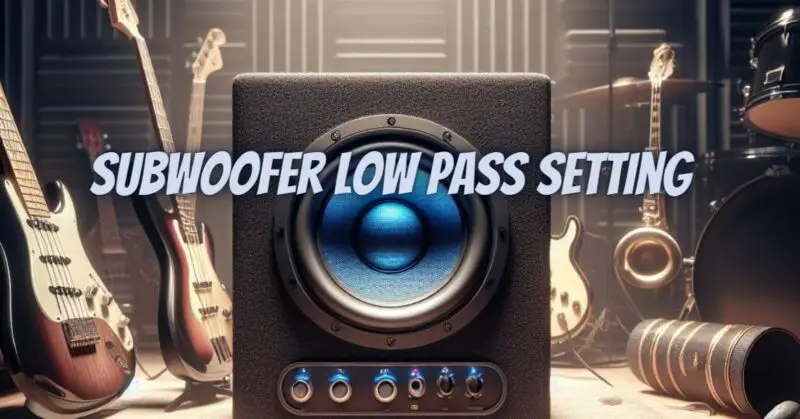In the world of audio, the subwoofer low-pass setting is a fundamental parameter that can significantly impact your listening experience. This setting determines the range of frequencies your subwoofer will reproduce, making it a crucial element in achieving balanced and immersive sound. In this comprehensive guide, we will explore what the subwoofer low-pass setting is, why it matters, and how to set it to perfection for your specific audio system.
Understanding the Subwoofer Low-Pass Setting
The subwoofer low-pass setting, often referred to as the crossover frequency or simply the crossover, is a key control on your subwoofer or audio receiver. It defines the point at which your subwoofer begins to roll off, allowing it to handle lower frequencies while letting your main speakers take care of the higher frequencies. This division of labor ensures that each component of your audio system operates within its optimal range.
Key Components of the Subwoofer Low-Pass Setting:
- Crossover Frequency: This is the primary parameter you’ll adjust. It denotes the frequency, measured in Hertz (Hz), at which the subwoofer starts to attenuate or reduce its output. Frequencies below this point are reproduced by the subwoofer, while those above it are directed to the main speakers.
- Slope or Roll-off Rate: The roll-off rate determines how steeply the subwoofer attenuates frequencies above the crossover point. Common slopes include 12 dB/octave and 24 dB/octave, with steeper slopes providing a more abrupt transition.
- Phase Control: Some subwoofers and receivers also offer a phase control that lets you adjust the timing or alignment of the subwoofer’s output relative to the main speakers. This can be useful for fine-tuning the integration of the subwoofer with your main speakers.
Importance of the Subwoofer Low-Pass Setting
The subwoofer low-pass setting plays a critical role in shaping your audio system’s sound quality and overall performance. Here’s why it’s essential:
- Frequency Separation: By directing lower frequencies to the subwoofer and higher frequencies to the main speakers, the low-pass setting ensures that each component operates within its optimal range, reducing the risk of distortion and improving overall clarity.
- Bass Management: Properly setting the low-pass crossover frequency allows you to manage the bass frequencies effectively, ensuring that they are not overpowering or too weak in relation to the rest of the audio spectrum.
- Room Acoustics: Different rooms have different acoustics, and the low-pass setting can be adjusted to account for the specific characteristics of your listening environment, such as room size and shape.
- Speaker Compatibility: It allows you to tailor the subwoofer’s output to complement your main speakers, especially when using different speaker models or brands in your system.
Setting the Subwoofer Low-Pass Setting
Achieving the ideal subwoofer low-pass setting involves a series of steps and considerations to ensure a harmonious integration with your main speakers and room acoustics. Here’s a comprehensive guide to help you make the most of this essential control:
- Understand Your Main Speakers:
- Start by familiarizing yourself with the specifications of your main speakers, particularly their frequency response capabilities. This information will guide you in selecting an appropriate crossover frequency.
- Consider Room Acoustics:
- Take into account the acoustics of your room. Larger and more reflective rooms may benefit from a lower crossover point, while smaller and well-damped rooms may work well with a higher crossover setting.
- Manufacturer Recommendations:
- Manufacturers often provide recommended crossover settings for their subwoofers based on the specific model and intended use. This can serve as a starting point for your adjustments.
- Use Room Calibration Tools:
- Many AV receivers and subwoofer processors offer room calibration tools that can automatically set the crossover frequency based on room measurements and speaker characteristics. These tools can be a valuable resource in fine-tuning your setup.
- Experiment and Listen:
- The best way to find the perfect low-pass setting is through experimentation. Begin with your chosen starting point (e.g., 80 Hz) and gradually adjust the crossover frequency up or down. Listen to a variety of audio content to assess how well the subwoofer integrates with your main speakers.
- Adjust the Slope (if available):
- Some subwoofers and AV receivers allow you to adjust the roll-off rate or slope. A steeper slope can provide a more abrupt transition, which may be necessary if you have clear separation between your subwoofer and main speakers.
- Utilize Phase Control (if available):
- Experiment with the phase control settings to align the phase of the subwoofer’s output with that of the main speakers. This can help prevent phase cancellation issues and improve integration.
- Trust Your Ears:
- Ultimately, your ears should be the final judge. Listen carefully to music and movies and trust your judgment. If the bass sounds too boomy or thin, make further adjustments until you achieve a balanced and natural sound.
The subwoofer low-pass setting is a vital control that empowers you to fine-tune your audio system for optimal performance. By following the steps outlined in this comprehensive guide and taking the time to adjust and fine-tune your subwoofer’s low-pass setting, you can achieve a seamless integration between your subwoofer and main speakers. The result is a rich and immersive audio experience that enhances your enjoyment of music, movies, and all forms of entertainment. Remember that the ultimate goal is to create a harmonious blend of frequencies that delivers powerful and accurate bass while complementing the rest of your audio system.


